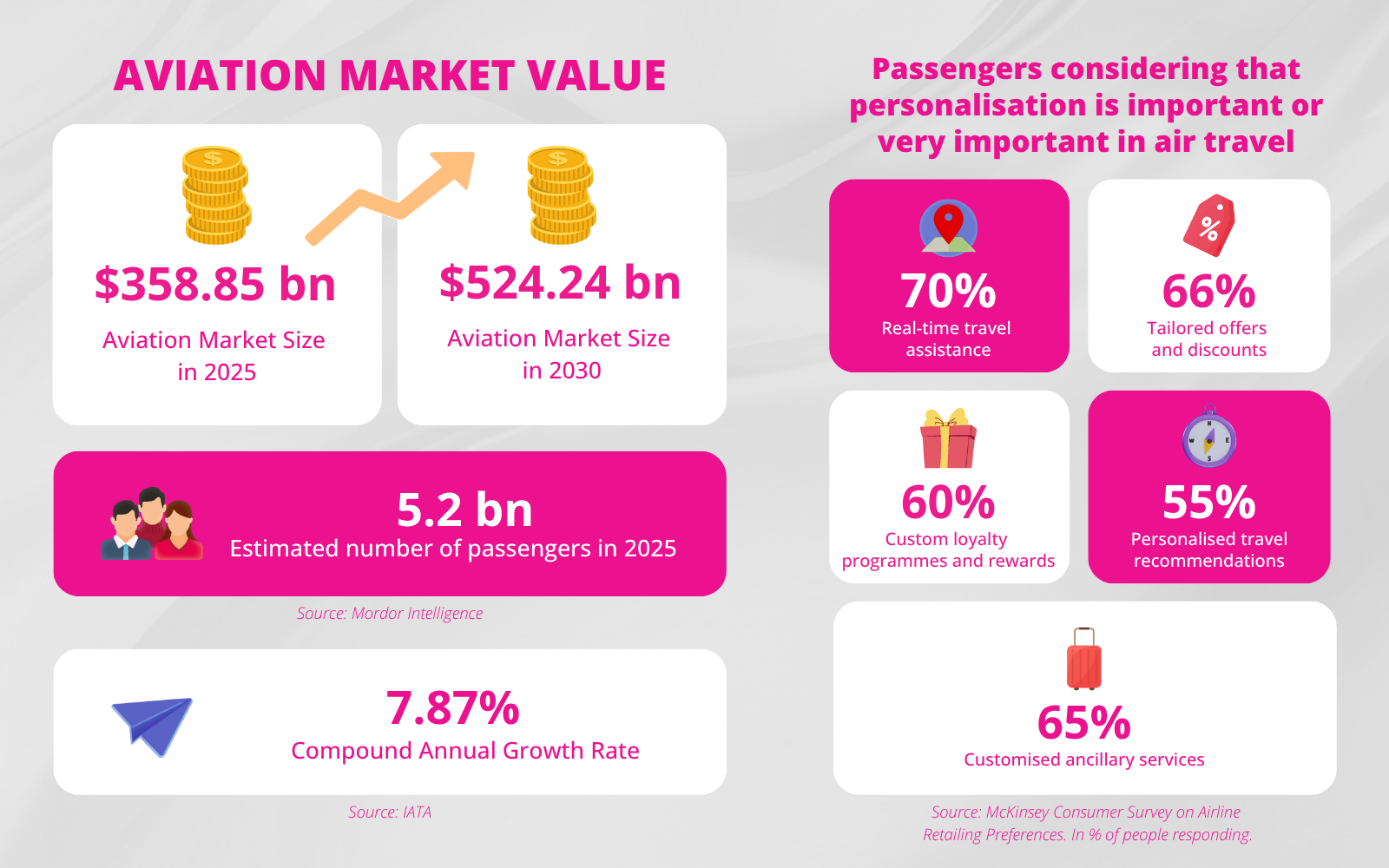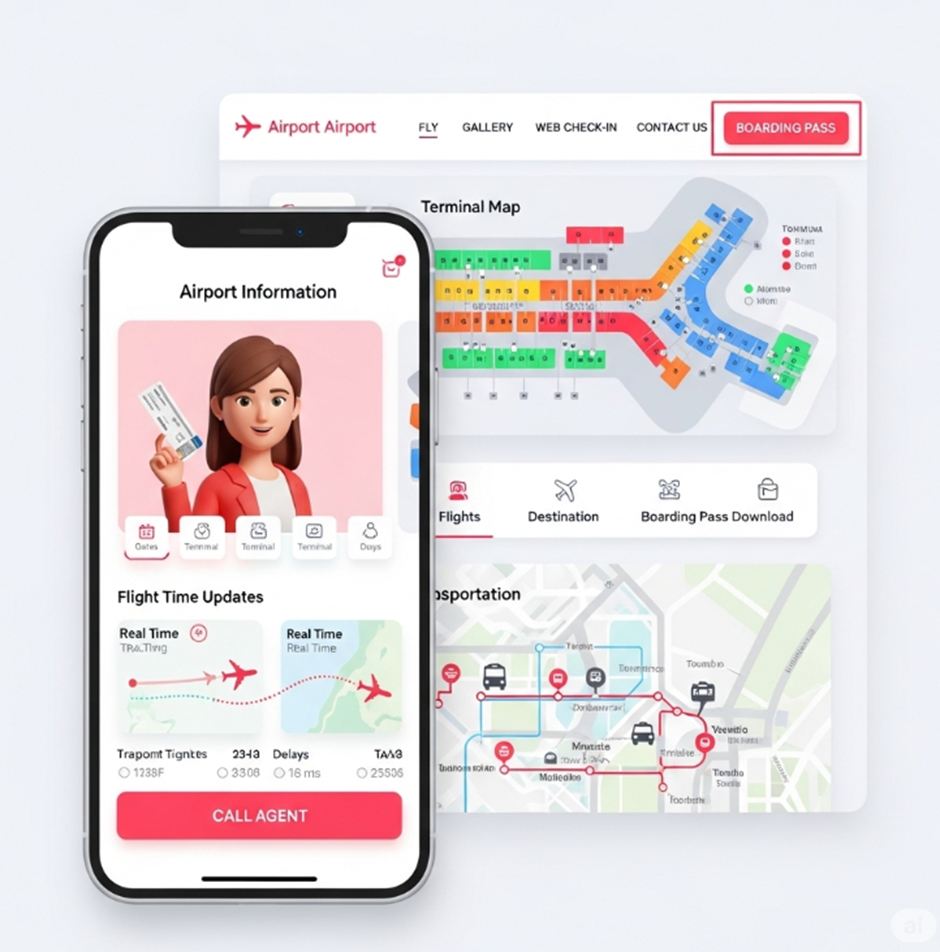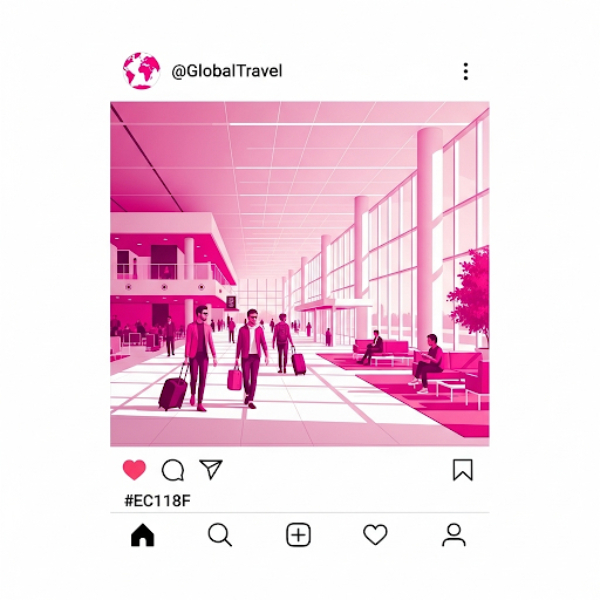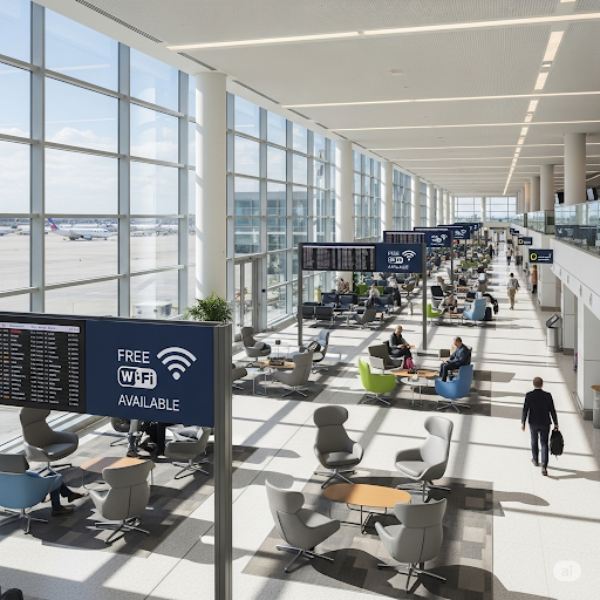Airports have become dynamic hubs driving local economies and creating memorable experiences for travellers. With the aviation industry set to grow to USD 358.85 billion in 2025 and USD 524.14 billion by 2030 at a Compound Annual Growth Rate (CAGR) of 7.87%, staying ahead of marketing trends is crucial to attract passengers, airlines, and other partners, especially for small and medium sized airports. Moreover, IATA expects over five billion passengers in 2025. Aviation marketing is evolving rapidly and airports must navigate both B2B and B2C landscapes. From collaborating with airlines and retail partners to offering personalised digital experiences to travellers, airports are redefining how they engage with every stakeholder.

Marketing has become more about relevance, resilience, and remembering who passes through your doors. Let’s dive into the key trends shaping aviation marketing in 2025-2026, and how airports can stay ahead.
Fueling Marketing with Digital Transformation: Data–Driven
Passenger Connections
Airports are increasingly becoming digital platforms driven by AI, machine learning, and data analytics. From check-in to boarding, self-service technologies are streamlining modern airport operations to increase automation and targeted passenger services while enabling richer engagement. It’s about listening to your passengers and using data to truly understand the people walking through your doors. A full-scale overhaul is not required. The process can begin by leveraging the data already available. Use simple AI and machine learning to understand passenger flow and offer targeted services. For example, delayed passengers could automatically receive a message with updated flight information and an additional service offer, reinforcing the relationship through data-driven communication.
Even a basic, well-designed mobile app or a responsive website can be a game-changer. Integrated platforms can be implemented to share information seamlessly between airports, airlines, and vendors. This is about making sure airlines and vendors are all on the same page, so your passengers get one seamless experience.

Airports that use platforms that save searches across devices and provide consistent personalisation across platforms tend to capture more bookings and build stronger customer relationships over time. The airports that will stand out in 2026 will be the ones that make this digital experience truly memorable, building a loyal community that keeps coming back.
Personalisation must Deliver Simplicity, Relevance, and Real-Time
Value
In 2025, personalisation is not about “customisation for the sake of it” or about “over-choice.” A McKinsey study reveals that travellers today are looking for less noise and more practical value. They value clarity, control, comfort, peace of mind, and ease of navigation. It should be “simple, useful, and relevant”. You can start by focusing on what travellers truly value: real-time assistance. A practical example is providing travellers with real-time alerts on gate changes or delays, complemented by clear guidance to their updated location. This type of timely, relevant communication helps them feel in control and at ease. Generative AI can be integrated to enable conversational trip planning, booking, locating available parking, finding stores and engaging in other intuitive chatbot interactions.
While big airports might use complex systems, small and medium-sized airports can achieve this with simple, strategic steps. By using basic data analytics and traveller feedback, you can start tailoring your communications and offers. This could be as simple as a pre-flight email with information relevant to their specific journey or a chatbot that can answer common questions. This approach builds a stronger connection with your passengers and transforms their experience from just passing through to feeling truly looked after.
“Travellers today are looking for less noise and more practical value. They value clarity, control, comfort, peace of mind, and ease of navigation.”
Attracting Flights and Visitors Through Strategic Destination
Marketing
Airports today must do more to attract flights. It’s about selling your entire region. An airport must position itself as a strategic gateway to the region it serves. This requires strategic partnerships with tourism boards, airlines, and local businesses to co-create compelling narratives, data-driven marketing, and innovative tools to create demand and ensure route sustainability.
A great strategy to increase revenue is route promotion outside of peak season. An exemplary case of such a successful route promotion is the strategy of the Malta International Airport to position Malta as a year-round destination rather than a summer destination. This was the outcome of proactive airline engagement, joint marketing campaigns, and promoting Malta’s touristic attractions. This strategy goes beyond just joint ad campaigns. As in the case of Corfu Airport in Greece, you can offer airlines incentives to operate in the off-season or create unique, targeted travel packages. Imagine a “Weekend Getaway“ deal for young professionals that bundles flights, a stay at a local boutique hotel, and passes to a regional festival.

Iceland’s Reykjavik Keflavik Airport works closely with the Icelandic Tourism Board to market the country’s natural wonders such as geysers and glaciers while Dubai International Airport positions itself as a gateway to luxury and adventure with campaigns showcasing desert safaris, shopping festivals and world-class hospitality. By promoting your area’s unique cultural draws and working as a unified team, your airport can attract flights and passengers by making your destination a must-see, no matter the season.
From Dreaming to Departure: Supporting the Full Travel Journey with Smart Planning Tools
Many travellers genuinely enjoy the travel planning process and the control they have over it. As a small or medium-sized airport, you can become an essential partner in this entire journey – from the moment a traveller starts dreaming about their destination to the second they depart.
This is about becoming a complete travel resource. Airport websites or apps can display information about local attractions and offer booking engine that integrates flights with car rentals, accommodation, local activities, and other services. By partnering with local providers, you can go even further. Airports can also support the journey by facilitating curated travel packages that combine flights, accommodation, insurance, transfers, car rentals, and activities.
Airports can also implement a digital marketplace to your website or mobile application to offer a seamless experience, integrating with accommodations, car rentals, and activities to drive conversions directly from the airport’s site.
By supporting the full travel planning process, your airport builds a relationship with travellers from the very beginning. You transform from a simple transit hub into a trusted guide, making their entire experience seamless and memorable.
“Airport websites or apps can display information about local attractions and offer booking engine that integrates flights with car rentals, accommodation, local activities, and other services.”
Content Is the New Gate: How Airports Use Stories, Social, and SEO to Drive Growth
An airport’s website and social media are the front door to your brand. By becoming content creators, you can build trust, grow your brand, and turn casual visitors into a loyal community. It’s about using stories, social media, and search engine optimisation (SEO) to build a powerful connection with travellers. High-performing content includes travel guides, cultural highlights, flight hacks, user-generated content such as travel vlogging, celebrity sightings or events at the airport, and video series featuring behind-the-scenes airport operations or local culinary experiences. This type of content makes your airport a thought leader and a trusted travel companion.
Social media is your real-time conversation with passengers. Use it as a service desk to provide live updates and answer questions, which builds trust and a reputation for great service. Airports can also conduct interactive initiatives such as surveys or engagement campaigns to strengthen their relationship with passengers. Live updates and stories can deliver real-time traffic or weather information to travellers. These platforms can be used as active conversion and feedback channels.

London Southend Airport achieved 250% year-on-year passenger growth between 2023 and 2024 and opened 10 new routes in 2024 by implementing creative marketing strategies such as rail station sponsorships, collaboration with popular influencers and disruptive campaigns at industry events. By leveraging the power of content and social media, your airport can drive growth and create a brand that people love.
From Transit Hubs to Retail Hubs: Marketing the Airport as a Destination to Shop
An airport’s retail space is a crucial source of revenue and a key part of your brand. Smart retail marketing has become a key pillar as airports double down on non-aeronautical streams of revenue. The goal is to move beyond generic gift shops and transform your airport into a shopping destination with a local, authentic feel. Focus on offering something unique to your region. Partnerships with local artisans, food producers, or boutiques can provide travellers with an authentic experience of the region. This not only supports small businesses but also makes their shopping experience more memorable.
Some of the trends to watch include real-time discount alerts via passenger tracking and technologies such as Bluetooth and Wi-Fi tracking, online ordering with in-terminal pickup or offsite delivery, and AI-powered dynamic product recommendations that personalise offers.
“Partner with local artisans, bakeries, or boutiques to give travellers a real taste of your community.”
Green Gets Noticed: How Sustainability Is Becoming a Key Airport Marketing Asset
Airports are increasingly becoming eco-conscious. Sustainability is a growing priority as airports invest in renewable energy and efficient systems. Travellers today are more aware than ever, and they want to support businesses that share their values. By showcasing your commitment to the environment, you can build a brand that stands for both growth and responsibility. Focus on smart, small steps that can make a big impact. This could be as simple as switching to energy-efficient lighting, implementing clear recycling programs, or highlighting your partnerships with eco-conscious airlines. For example, Copenhagen Airport aims for net zero emissions by 2030 and it has been accredited in the International Airport Carbon Accreditation (ACA) scheme. The key is to communicate these efforts clearly to your travellers. Airports that showcase their sustainability efforts are showing travellers that growth and responsibility can go hand in hand. Think about turning your green initiatives into a brand story. You can integrate tools on your website or app that measure and highlight your environmental progress, helping travellers make informed decisions about their journey.

Airports can also partner with airlines to promote routes operated by fuel-efficient aircraft. By actively promoting these efforts, your airport can attract passengers and airlines who want to be part of a sustainable future.
Loyalty Beyond Miles: Personalised Rewards That Drive Repeat Visits
Loyalty in 2025 isn’t just about frequent flyer miles. It’s about building a genuine emotional connection and offering your passengers tangible value. You want to make them feel like a valued guest, not just another ticket number.
The best way to do this is with a simple, thoughtful rewards program. Think beyond just offering points for flights. You can create a tiered reward system that gives repeat visitors benefits like discounts at your airport restaurants, express security lanes, or even free lounge access.
To go even further, consider cross-industry partnerships. Collaboration with local retailers, hotels, or car rental companies can generate exclusive offers that enhance the overall travel experience. Personalised perks can be offered based on user behaviour, not just transaction volume. For instance, offering bonus points for purchasing the customer’s favourite item. This approach encourages repeat visits and boosts spending, creating a win-win for airports and travellers alike.
“You can team up with local retailers, hotels, or car rental companies to offer exclusive deals that make the entire trip better.”
Infrastructure as Influence: How Airport Facilities Shape Brand Perception
Elements such as clean terminals, clear signage, reliable free Wi-Fi, and comfortable waiting areas are integral components of an airport’s brand perception. Airport infrastructure is a powerful marketing tool that showcases an airport’s efficiency, modernity, and commitment to passenger experience, attracting airlines, businesses, and travellers alike. State-of-the-art facilities, such as advanced check-in systems, biometric security, and eco-friendly designs, highlight innovation, enticing airlines to establish hubs and passengers to choose the airport. Highlight recent upgrades – free Wi-Fi, comfortable lounges, or efficient security – as part of your brand. If your airport has a standout feature (art, play areas, or local food), make it a central theme of your marketing.
For instance, the iconic Jewel complex of Singapore’s Changi Airport, with its stunning waterfall, canopy park, and retail offerings, markets itself as a destination in its own right. But even a simple space, when designed with care, becomes memorable. Emphasis on punctuality, cleanliness, and ease of navigation signals reliability. By highlighting infrastructure like high-speed Wi-Fi, smart lounges, and sustainable energy systems, airports can build a compelling brand narrative that resonates with stakeholders.

Conclusion: Becoming the Airport of Choice in 2025-2026 with a Data Strategy
To stand out in the increasingly competitive travel landscape of 2025-2026, airports should embrace data, technology, and customer-centric marketing and show thoughtfulness in functionality. By prioritising data integration and investing in personalisation through mobile platforms, airports can enhance traveller satisfaction. Collaborating with tourism boards for destination marketing, adopting eco-conscious technologies for sustainability, refining retail experiences, and maintaining engagement through creative content marketing further boost operational efficiency. Strategic use of digital tools and data driven analytics can further enhance route marketing and passenger engagement. Partnering with technological and marketing platforms that support seamless digital transformation can empower airports to better understand traveller behaviour and deliver more relevant, timely experiences. Airiane solutions offer practical support, ensuring airports enhance operations, boost revenue, and meet traveller expectations. Embracing these approaches positions airports as a memorable and influential part of the travel journey.